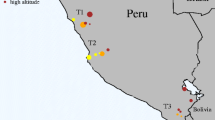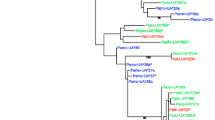Abstract
In order to understand the expression and evolution of host resistance to pathogens, we need to examine the links between genetic variability at the major histocompatibility complex (Mhc), phenotypic expression of the immune response and parasite resistance in natural populations. To do so, we characterized the Mhc class I and IIB genes of house sparrows with the goal of designing a PCR-based genotyping method for the Mhc genes using denaturing gradient gel electrophoresis (DGGE). The incredible success of house sparrows in colonizing habitats worldwide allows us to assess the importance of the variability of Mhc genes in the face of various pathogenic pressures. Isolation and sequencing of Mhc class I and IIB alleles revealed that house sparrows have fewer loci and fewer alleles than great reed warblers. In addition, the Mhc class I genes divided in two distinct lineages with different levels of polymorphism, possibly indicating different functional roles for each gene family. This organization is reminiscent of the chicken B complex and Rfp-Y system. The house sparrow Mhc hence appears to be intermediate between the great reed warbler and the chicken Mhc, both in terms of numbers of alleles and existence of within-class lineages. We specifically amplified one Mhc class I gene family and ran the PCR products on DGGE gels. The individuals screened displayed between one and ten DGGE bands, indicating that this method can be used in future studies to explore the ecological impacts of Mhc diversity.






Similar content being viewed by others
References
Apanius V, Penn D, Slev PR, Ruff LR, Potts WK (1997) The nature of selection on the major histocompatibility complex. Crit Rev Immunol 17:179–224
Briles WE, Stone HA, Cole RK (1977) Marek’s disease: effects of B histocompatibility alloalleles in resistant and susceptible chicken lines. Science 195:193–195
Brown JL, Eklund A (1994) Kin recognition and the major histocompatibility complex: an integrative review. Am Nat 143:435–461
Edwards SV Wakeland EK, Potts WK (1995) Contrasting histories of avian and mammalian MHC genes revealed by class II B sequences from songbirds. Proc Natl Acad Sci USA 92:12200–12204
Edwards SV, Gasper J, March M (1998) Genomics and polymorphism of Agph-DAB1, an Mhc class II B gene in red-winged blackbirds (Agelaius phoeniceus). Mol Biol Evol 15:236–250
Guillemot F, Billault A, Pourquié O, Béhar G, Chaussé A-M, Zoorob R, Kreibich G, Auffray C (1988) A molecular map of the chicken major histocompatibility complex: the class IIβ genes are closely linked to the class I genes and the nucleolar organizer. EMBO J 7:2775–2785
Gu X, Nei M (1999) Locus specificity of polymorphic alleles and evolution by a birth-and-death process in mammalian MHC genes. Mol Biol Evol 16:147–156
Hall TA (1999) BioEdit: a user-friendly biological sequence alignment editor and analysis program for Windows 95/98/NT. Nucleic Acids Symp Ser 41:95–98
Hill AVS, Allsopp CEM, Kwiatkowski D, Anstey NM, Twumasi P, Rowe PA, Bennett S, Brewster D, McMichael AJ, Greenwood BM (1991) Common West African HLA antigens are associated with protection from severe malaria. Nature 352:595–600
Hughes AL, Nei M (1988) Patterns of nucleotide substitution at major histocompatibility complex class I loci reveals overdominant selection. Nature 335:167–170
Hughes AL, Nei M (1989) Nucleotide substitution at the major histocompatibility complex class II loci: evidence for overdominant selection. Proc Natl Acad Sci USA 86:958–962
Jacob JP, Milne S, Beck S, Kaufman J (2000) The major and a minor class II beta-chain (B-LB) gene flank the Tapasin gene in the B-F/B-L region of the chicken major histocompatibility complex. Immunogenetics 51:138–147
Janeway CA, Travers P, Walport M, Capra JD (1999) Immunobiology: the immune system in health and disease. Current Biology Publications, London
Juul-Madsen HR, Dalgaard TS, Afanassieff M (2000) Molecular characterization of major and minor MHC class I and II genes in B21-like haplotypes in chickens. Anim Genet 31:252–261
Kaufman J (1999) Co-evolving genes in MHC haplotypes: the “rule” for nonmammalian vertebrates. Immunogenetics 50:228–236
Kaufman J, Völk H, Wallny H (1995) A “minimal essential MHC” and an “unrecognized MHC”: two extremes in selection for polymorphism. Immunol Rev 143:63–88
Klein J, Satta Y, O’hUigin C, Takahata N (1993) The molecular descent of the major histocompatibity complex. Annu Rev Immunol 11:269–295
Kroemer G, Bernot A, Béhar G, Chaussé A, Gastinel L, Guillemot F, Park I, Thoraval P, Zoorob R, Auffray C (1990) Molecular genetics of the chicken MHC: current status and evolutionary aspects. Immunol Rev 113:119–145
Kumar S, Tamura K, Nei M (1993) MEGA: molecular evolutionary genetics analysis, version 1.01. The Pennsylvania State University, University Park, Penn.
Miller MM, Goto R, Bernot A, Zoorob R, Auffray C, Bumstead N, Briles WE (1994) Two MHC class I and two MHC class II genes map to the chicken Rfp-Y system outside the B complex. Proc Natl Acad Sci USA 91:4397–4401
Myers RM, Maniatis T, Lerman LS (1987) Detection and localization of single base changes by denaturant gradient gel electrophoresis. Methods Enzymol 155:501–527
Nei M, Gojobori T (1986) Simple methods for estimating the numbers of synonymous and nonsynonymous nucleotide substitutions. Mol Biol Evol 3:418–426
Nei M, Hughes AL (1992) Balanced polymorphism and evolution by the birth-and-death process in the MHC loci. In: Tsuji K, Aizawa M, Sasazuki T (eds) Proceedings of the 11th histocompatibility workshop and conference, vol 2. Oxford University Press, Oxford, pp 27–38
Nei M, Gu X, Sitinikova T (1997) Evolution by the birth-and-death process in multigene families of the vertebrate immune system. Proc Natl Acad Sci USA 94:7799–7806
Ober C (1992) The maternal-fetal relationship in human pregnancy: an immunological perspective. Exp Clin Immunogenet 9:1–14
O’Brien SJ, Roelke ME, Marker L, Newman A, Winkler CA, Meltzer D, Colly L, Evermann JF, Bush M, Wildt DE (1985) Genetic basis for species vulnerability in the cheetah. Science 227:1428–1434
Parham P, Lomen CE, Lawlor DA, et al (1988) Nature of polymorphism in HLA-A, -B, and -C molecules. Proc Natl Acad Sci USA 85:4005–4009
Potts WK, Wakeland EK (1990) Evolution of diversity at the major histocompatibility complex. Trends Evol Ecol 5:181–187
Potts WK, Wakeland EK (1993) Evolution of MHC genetic diversity: a tale of incest, pestilence and sexual preference. Trends Genet 9:408–412
Reusch TBH, Häberli MA, Aeschlimann PB, Milinski M (2001) Female sticklebacks count alleles in a strategy of sexual selection explaining MHC polymorphism. Nature 414:300–302
Richardson DS, Westerdahl H (2003) MHC diversity in two Acrocephalus species: the outbred Great reed warbler and the inbred Seychelles warbler. Mol Ecol 12:3523–3529
Rozas J, Rozas R (1999) DnaSP version 3: an intergrated program for molecular population genetics and molecular evolution analysis. Bioinformatics 15:174–175
Sanjayan MA, Crooks K, Zegers G, Foran D (1996) Genetic variation and the immune response in natural populations of pocket gophers. Cons Biol 10:1519–1527
Sato A, Figueroa, F, Mayer WE, Grant PR, Grant R, Klein J (2000) MHC class II genes of Darwin’s finches: divergence by point mutations and reciprocal recombination. In: Kasahara M (ed) Major histocompatibility complex: evolution, structure, and function. Springer, Tokyo Berlin Heidelberg, pp 518–541
Sato A, Mayer WE, Tichy H, Grant PR, Grant BR, Klein J (2001) Evolution of Mhc class II B genes in Darwin’s finches and their closest relatives: birth of a new gene. Immunogenetics 53:792–801
Sheffield VC, Cox DR, Lerman LS, Myers RM (1989) Attachment of a 40-base-pair G+C-rich sequence (GC-clamp) to genomic DNA fragments by the polymerase chain reaction results in improved detection of a single-base changes. Proc Natl Acad Sci USA 86:232–236
Singh PB, Brown RE, Roser B (1987). MHC antigens in urine as olfactory recognition cues. Nature 327:161–164
Summers-Smith JD (1988) The sparrows, a study of the genus Passer. Poyser, Calton, pp 114–161
Takahata N, Satta Y, Klein J (1992) Polymorphism and balancing selection at major histocompatibility complex loci. Genetics 130:925–938
Westerdahl H, Wittzell H, von Schantz T (1999) Polymorphism and transcription of MHC class I genes in a passerine bird, the great reed warbler. Immunogenetics 49:158–170
Westerdahl H, Wittzell H, von Schantz T (2000) Mhc diversity in two passerine birds: no evidence for a minimal essential Mhc. Immunogenetics 52:92–100
Wittzell H, Bernot A, Auffray C, Zoorob R (1999) Concerted evolution of two MHC class II B loci in pheasants and domestic chicken. Mol Biol Evol 16:479–490
Yamazaki K, Beauchamp GK, Kupniewski J, Bard J, Thomas L, Boyse EA (1988). Familial imprinting determines H-2 selective mating preferences. Science 240:1331–1332
Zelano B, Edwards SV (2002). An Mhc component to kin recognition and mate choice in birds: predictions, progress and prospects. Am Nat 160:S225–S237
Ziegler A, Gottfried D, Uchanska-Ziegler B (2002) Possible role for products of polymorphic MHC and linked olfactory receptor genes during selection processes in reproduction. Am J Rep Immunol 47:1–9
Zoorob R, Bernot A, Renoir DM, Choukri F, Auffray C (1993) Chicken major histocompatibility complex class II B genes: analysis of interallelic and interlocus sequence variance. Eur J Immunol 23:1139–1145
Acknowledgements
We thank D. Richardson, T. von Schantz and F. Depaulis for discussion and advice, J. Ewen for useful comments and R. Barbault (director of the Ecole Doctorale Diversité du Vivant) for financial help. This research was supported by grants from the CNRS to G.S. and R.Z. (ACI Jeunes Chercheurs to G.S. and the GDR 2155 ‘Ecologie Comportementale’ to G.S., O.C. and B.F.) and from the European Commission to R.Z. (KA5 RLRT-CT99-1591).
Author information
Authors and Affiliations
Corresponding author
Rights and permissions
About this article
Cite this article
Bonneaud, C., Sorci, G., Morin, V. et al. Diversity of Mhc class I and IIB genes in house sparrows (Passer domesticus). Immunogenetics 55, 855–865 (2004). https://doi.org/10.1007/s00251-004-0648-3
Received:
Revised:
Published:
Issue Date:
DOI: https://doi.org/10.1007/s00251-004-0648-3




